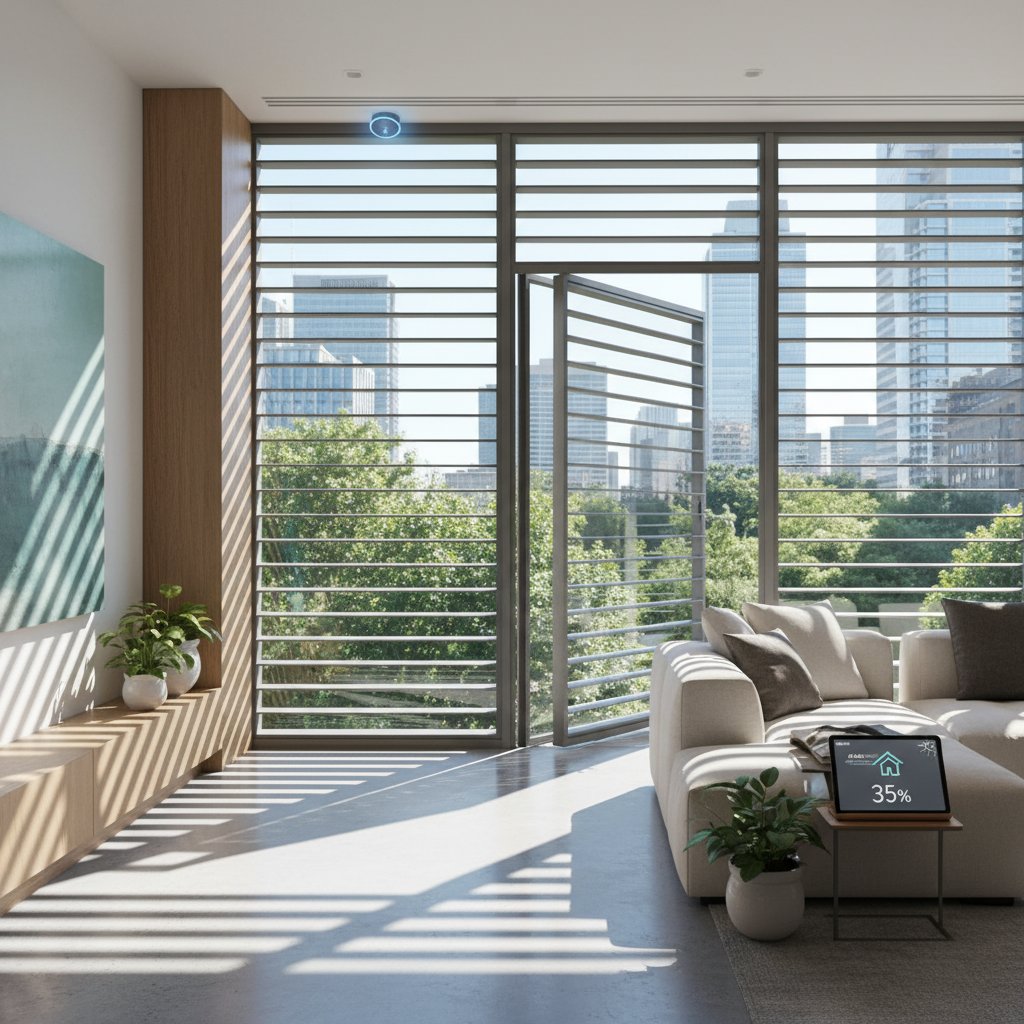Smart Blinds Cut AC Bills 35% with Solar Tracking
Smart homes evolve from optional features to essential systems that enhance daily life. Solar-tracking smart blinds represent a key advancement in this progression, offering precise control over sunlight to improve comfort and efficiency. These devices adjust automatically to reduce heat gain, which lowers air conditioning demands by up to 35 percent and positions them as a practical upgrade for energy-conscious homeowners.
The core strength of these blinds stems from their adaptive technology. They track solar positions using built-in sensors, responding dynamically to environmental changes. Homeowners benefit from cooler interiors, reduced utility expenses, and greater sustainability without ongoing manual adjustments.
This article examines the mechanics of solar-tracking blinds, their integration into home systems, and strategies for implementation to achieve measurable savings.
How Solar Tracking Works
Solar-tracking blinds incorporate sensors, connectivity features, and automation algorithms as their foundational elements.
- Sensors: These detect sunlight intensity, direction, and room temperature to inform real-time decisions.
- Connectivity: Integration with a central hub or mobile application allows coordination with thermostats, lights, and other devices.
- Automation: Software processes data on solar paths, positioning the blinds to optimize light and heat management throughout the day.
Picture a scenario where midday sun intensifies on south-facing windows. The system lowers the blinds to block excess heat while permitting diffused light for illumination. As the sun moves westward, the blinds raise gradually, maintaining balanced indoor conditions and minimizing reliance on mechanical cooling.
Real-World Example: Smarter Living in Action
In a typical urban residence, solar-tracking blinds synchronize with broader home automation. During peak afternoon heat, sensors identify rising temperatures from direct sunlight on east-facing exposures. The blinds descend partially to reflect infrared rays, preserving view and natural brightness.
The connected thermostat registers the temperature drop and scales back air conditioning cycles. Supplemental lighting activates subtly if needed, ensuring consistent ambiance. Such interplay demonstrates how these systems deliver efficiency in everyday settings.
Affordable options now extend this capability to standard households. Compatible with platforms like Google Home or Amazon Alexa, installation involves simple pairing via apps, enabling voice commands for overrides or custom routines.
Integration with Broader Smart Home Systems
Solar-tracking blinds amplify their impact within interconnected environments. They interface with unified platforms that manage lighting, climate control, and security seamlessly.
For example, at dawn, rising light triggers the blinds to open, signaling the thermostat to delay heating until optimal conditions arise. Upon departure, the system closes shades to shield interiors from UV damage and retain coolness.
Mobile applications provide oversight of operations, displaying metrics on blocked sunlight, adjustment frequency, and energy impacts. This visibility empowers users to refine configurations based on observed patterns.
Overcoming Barriers to Adoption
Despite evident advantages, several challenges impede widespread use of smart blinds. Initial costs exceed those of traditional shades, particularly for advanced solar-tracking models.
Market dynamics address this through increased manufacturing and rivalry, driving prices downward. Basic smart variants now deliver core features at accessible levels, with payback periods shortened by bill reductions of 20 to 35 percent annually.
Compatibility issues arise with diverse ecosystems, but emerging protocols like Matter standardize communication across brands. This fosters plug-and-play functionality, reducing setup frustrations.
Installation demands vary, yet innovations simplify the process. Solar-rechargeable batteries power many units without electrical modifications, while guided apps offer tutorials for alignment and testing.
The Sustainability Angle
Automated shading supports environmental goals by curtailing air conditioning use, which cuts greenhouse gas outputs significantly. These systems lessen strain on heating, ventilation, and air conditioning units, prolonging their operational life.
Models with integrated solar panels generate power from ambient light, powering mechanisms sustainably. This self-sufficient design exemplifies how technology harnesses natural resources to mitigate indoor climate challenges.
For eco-focused residents, such features align personal comfort with planetary stewardship, transforming routine adjustments into contributions to reduced energy consumption.
The Role of Design and Customization
Contemporary smart blinds prioritize aesthetics alongside functionality. Selections include varied fabrics for light filtration, from translucent weaves that soften glare to opaque panels for complete darkness.
Sleek, low-profile motors ensure minimal visual disruption, blending into diverse interior schemes. Custom sizing and material choices allow precise fits for unique window configurations.
This fusion of form and intelligence appeals to design enthusiasts, elevating window treatments beyond utility to enhance overall home character.
Data-Driven Insights for Smarter Living
Advanced analytics elevate solar-tracking systems by tracking usage and outcomes. Reports detail energy conserved, thermal variations, and solar exposure over time.
Suppose analysis shows peak heat from a bedroom window between 2 p.m. and 4 p.m. Users then schedule heightened shading for those hours, amplifying efficiency. Long-term data refines habits, yielding compounded benefits.
Developers leverage anonymized datasets from installations to enhance algorithms, adapting to regional weather and architectural variances for broader effectiveness.
Making It Happen
To adopt solar-tracking blinds, evaluate window orientations first. Prioritize areas with substantial southern or western exposures, where heat buildup drives high cooling costs.
Choose systems featuring robust sensors, app connectivity, and compatibility with existing devices. Verify quiet operation and energy-efficient power sources during selection.
Pair with smart thermostats for synergy; automatic shading prompts adjusted cooling, often halving runtime on intense days. Post-installation, track bills and comfort levels to quantify gains.
Many report steadier temperatures, eliminated hot spots, and fewer system activations, confirming the upgrade's value.
Achieving Balanced Home Efficiency
Solar-tracking smart blinds integrate technology with everyday needs, fostering homes that adapt intelligently. They deliver tangible reductions in costs and environmental footprints while enhancing livability. Implementing these solutions positions residences for enduring efficiency and well-being.
